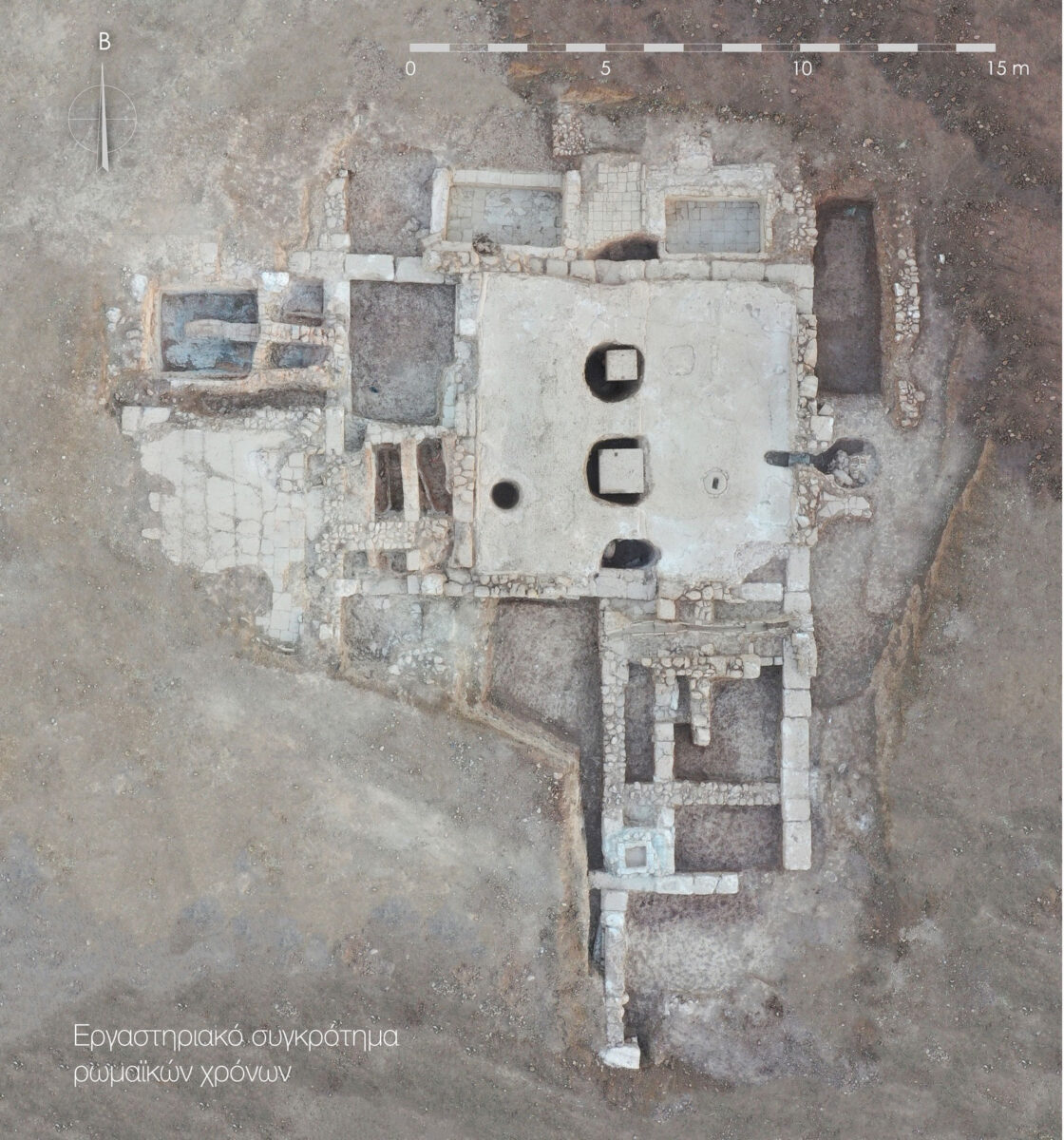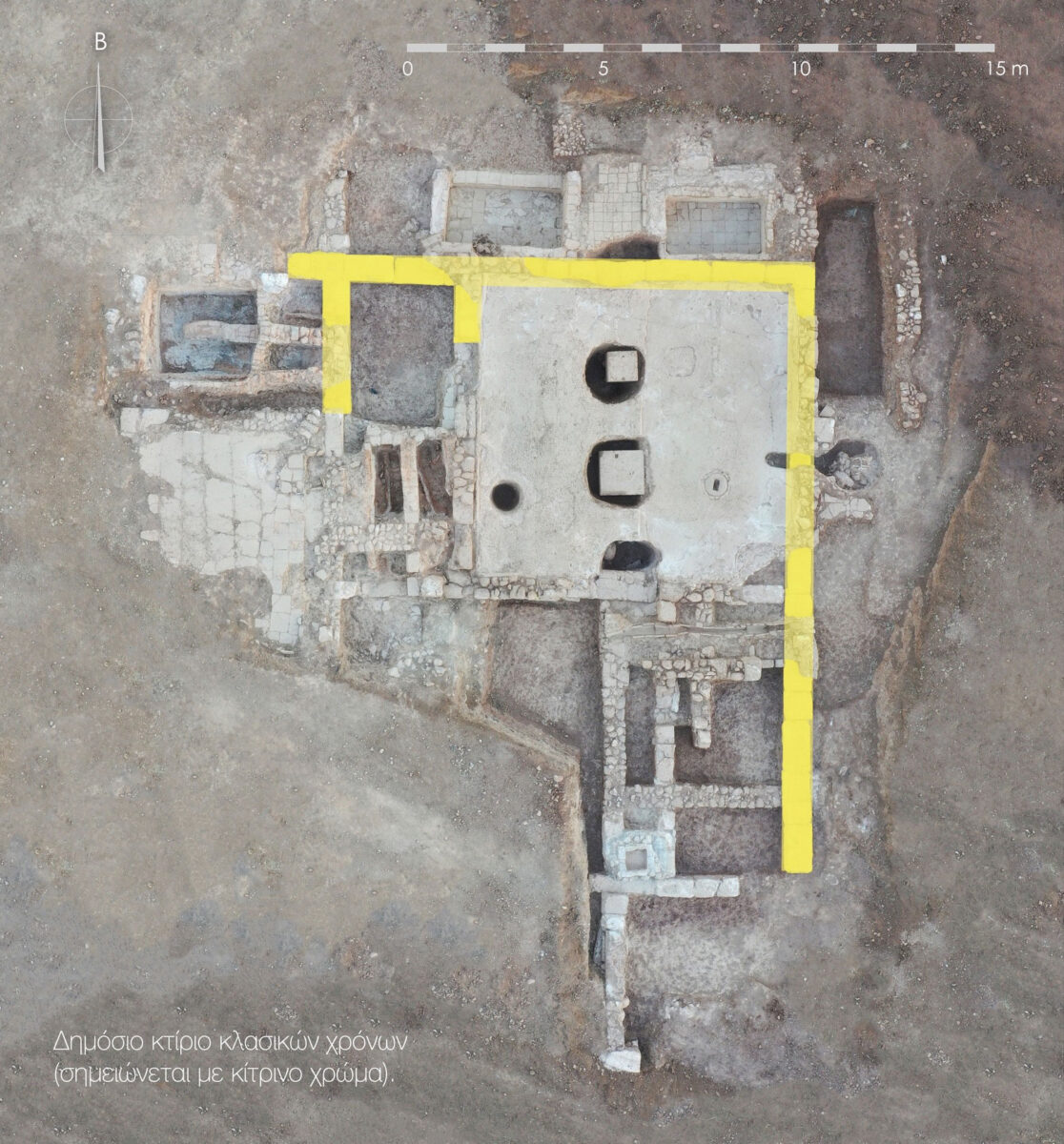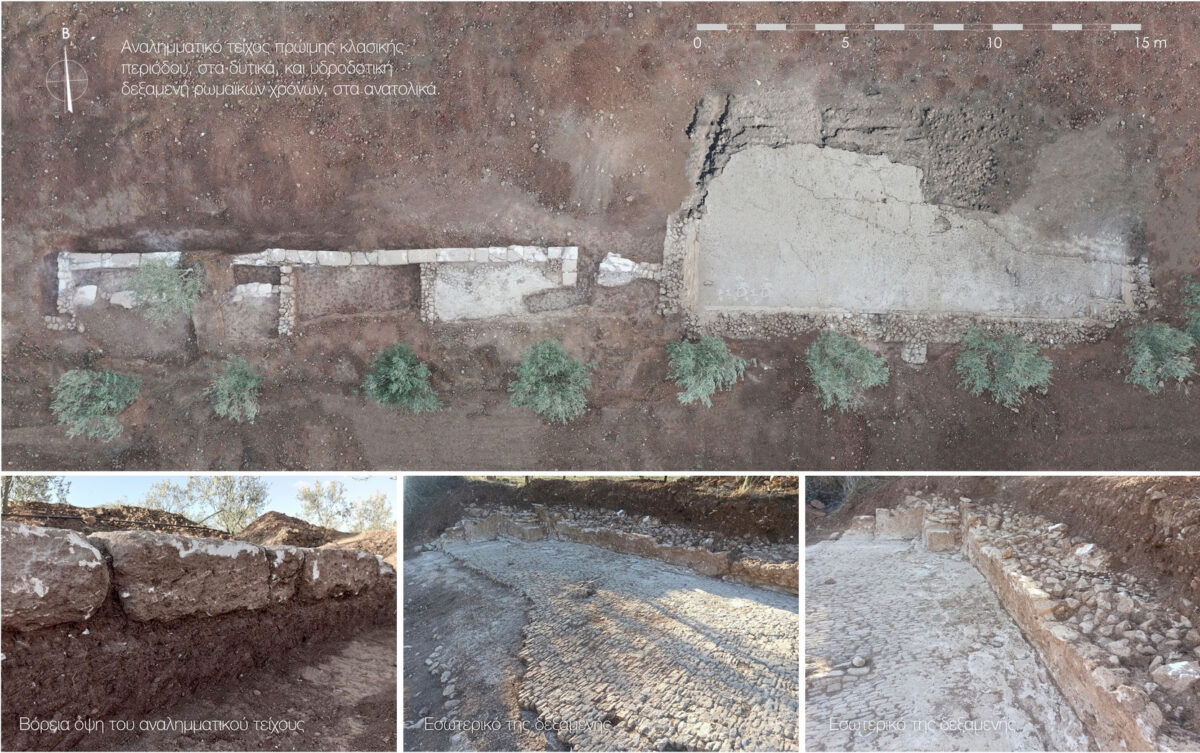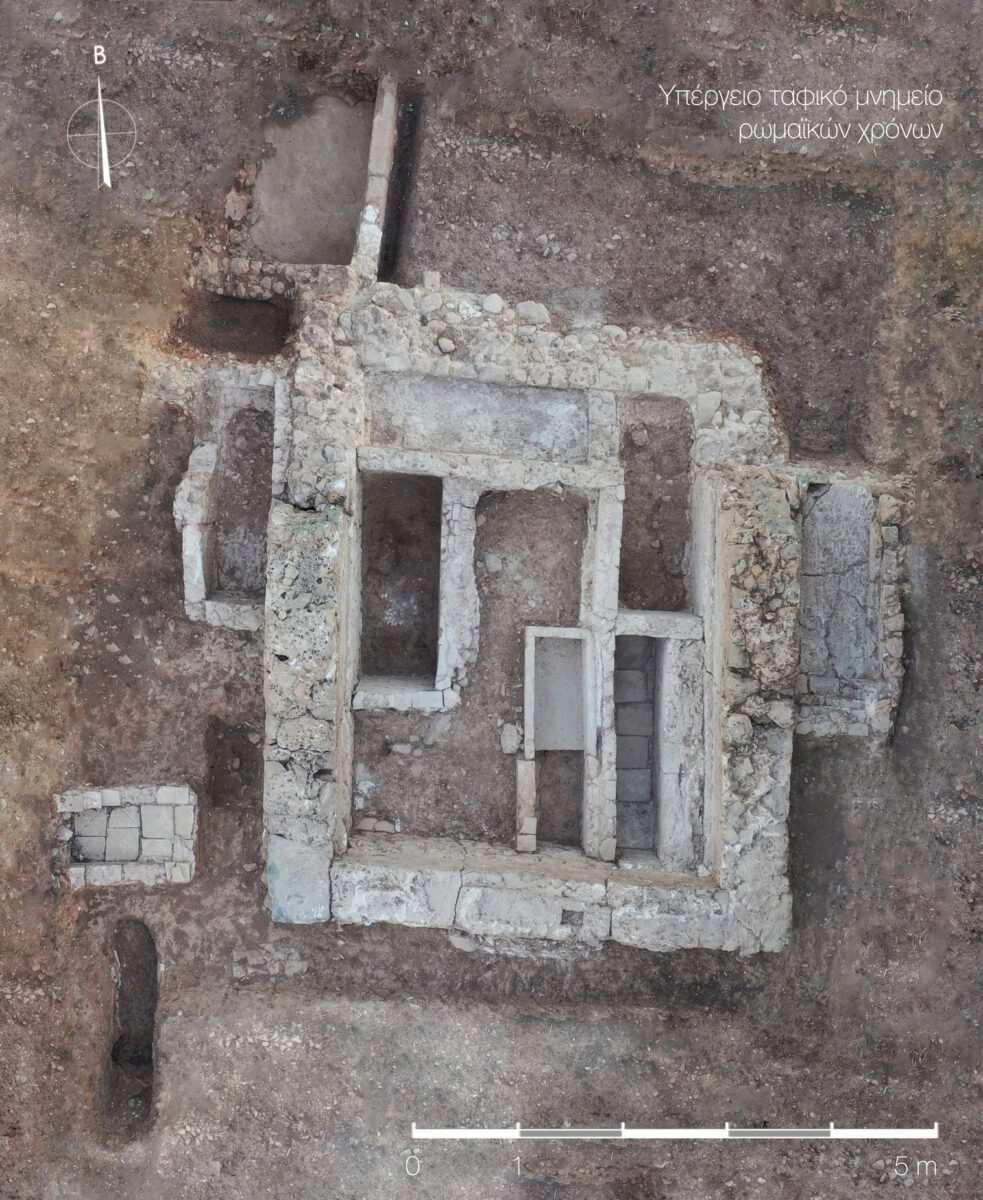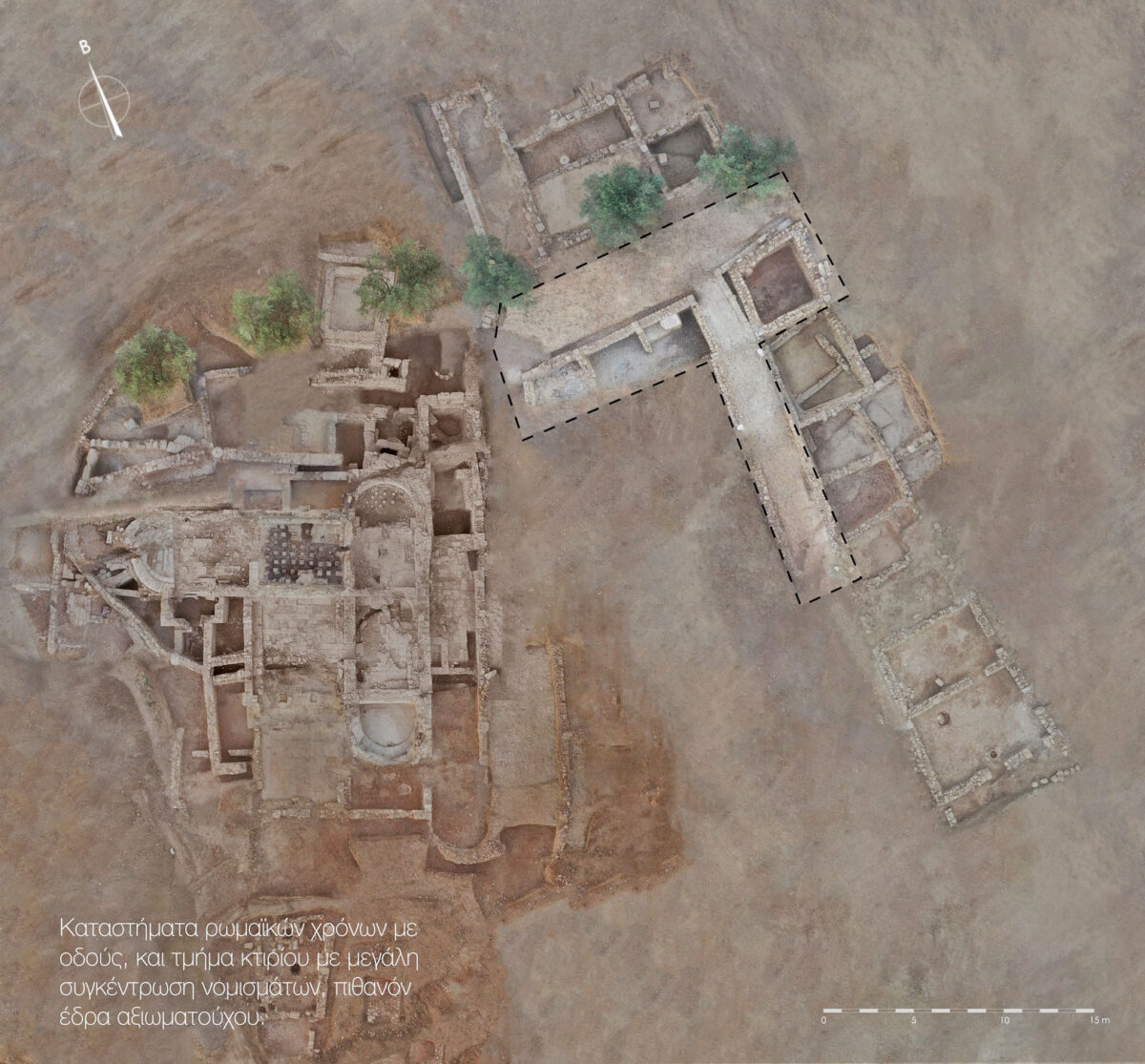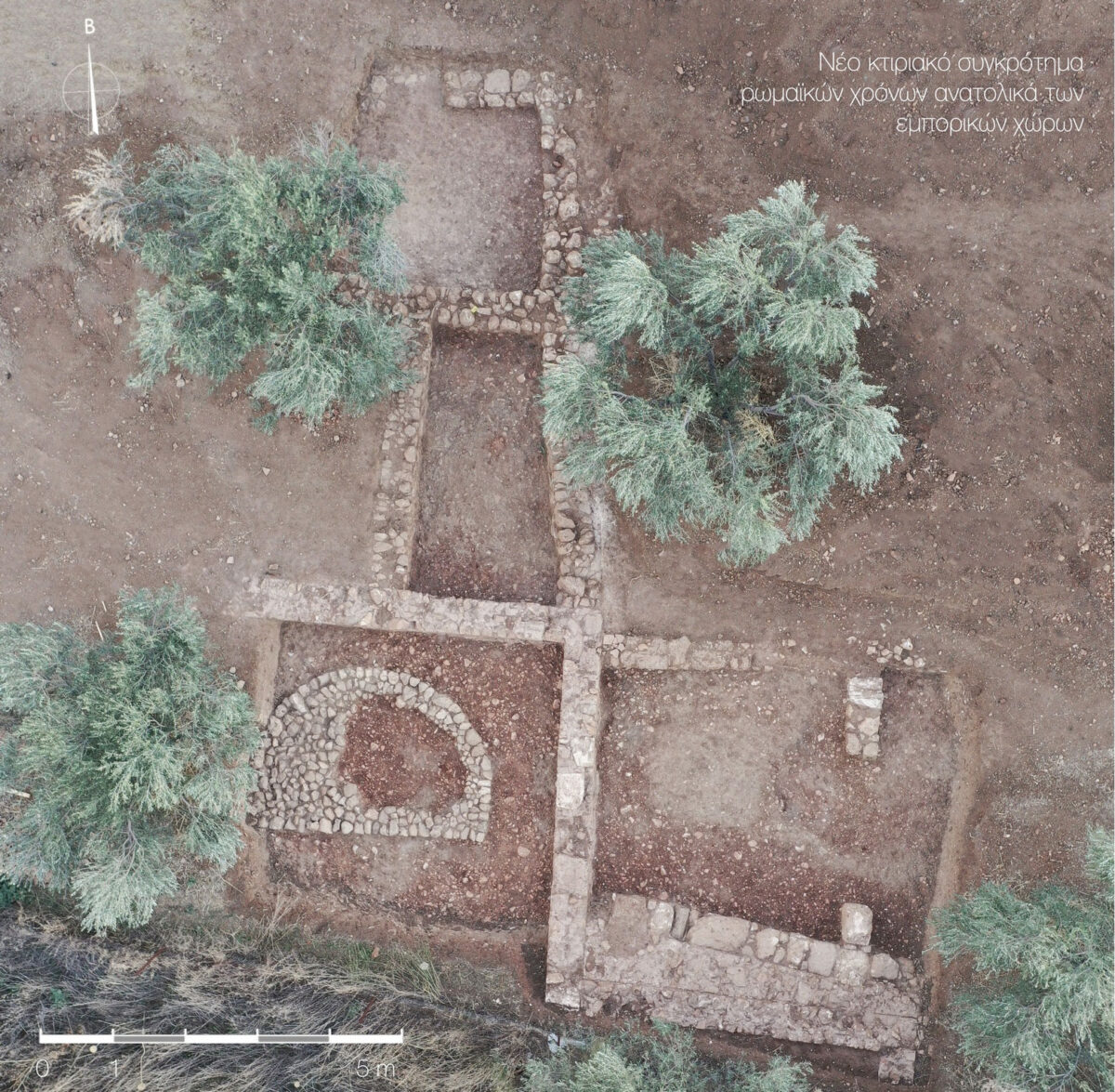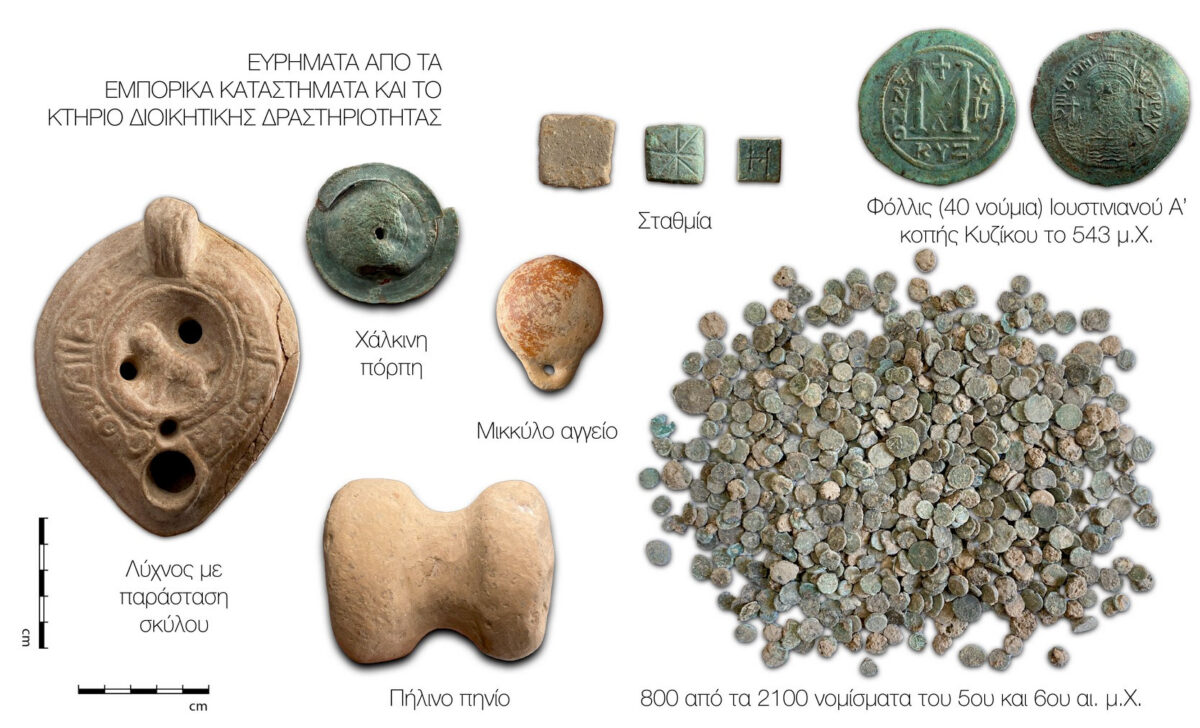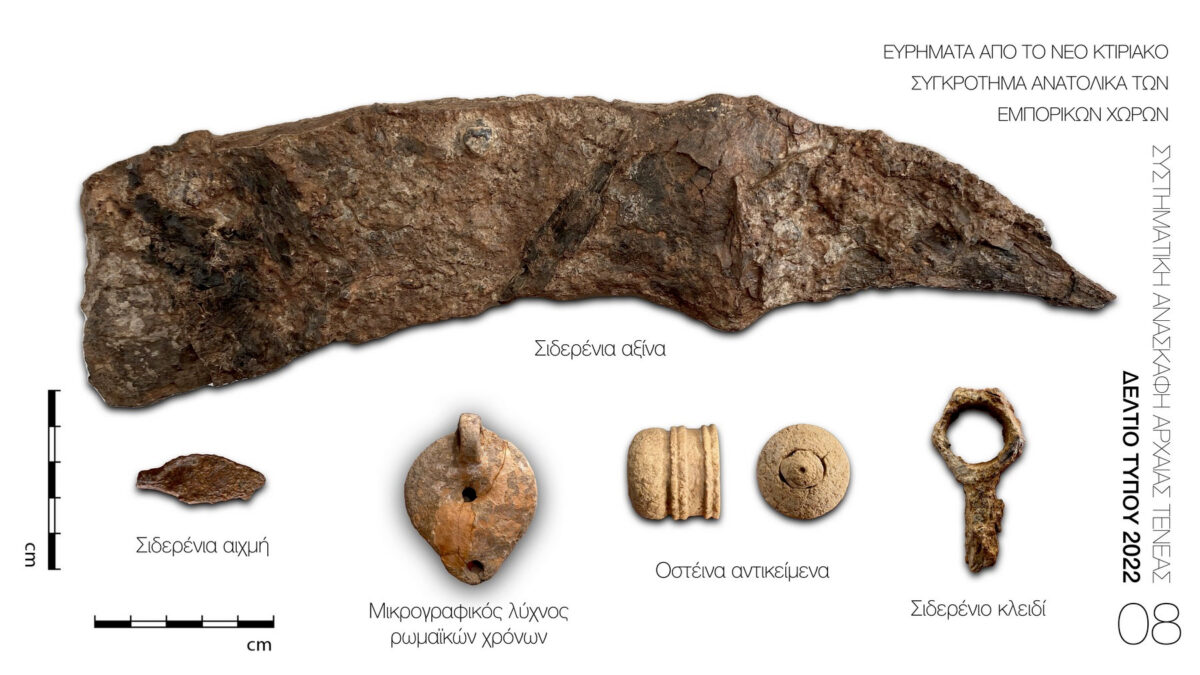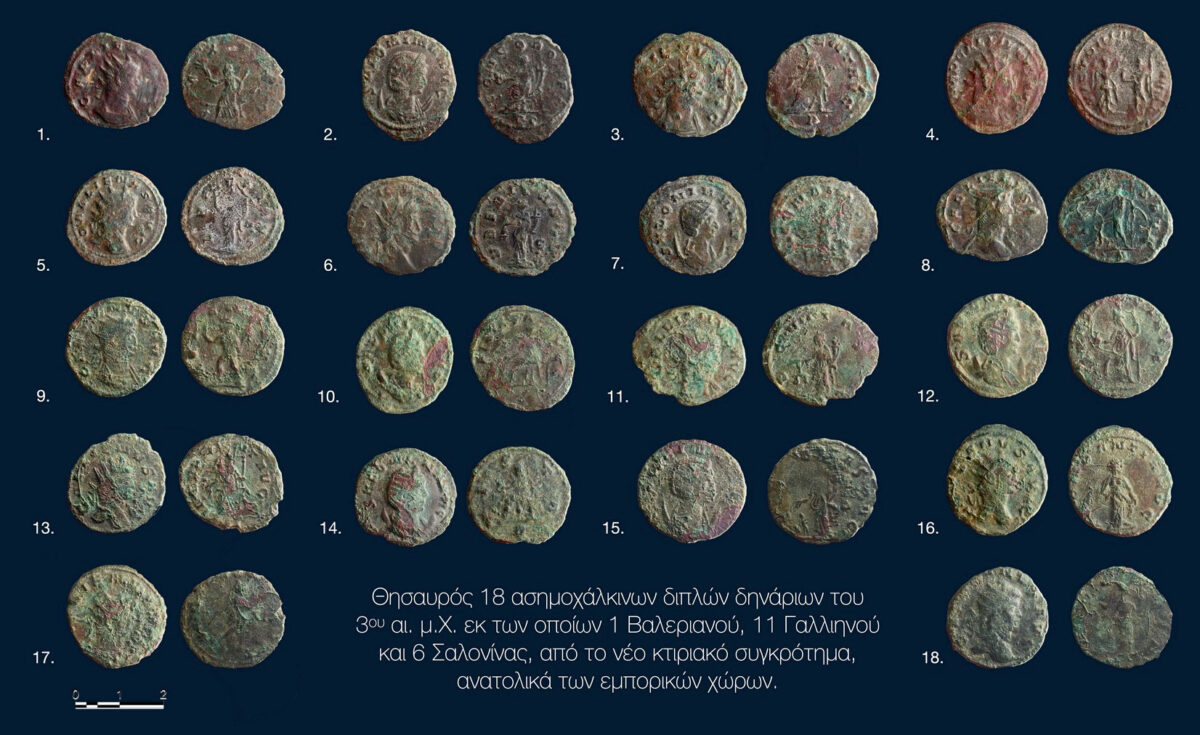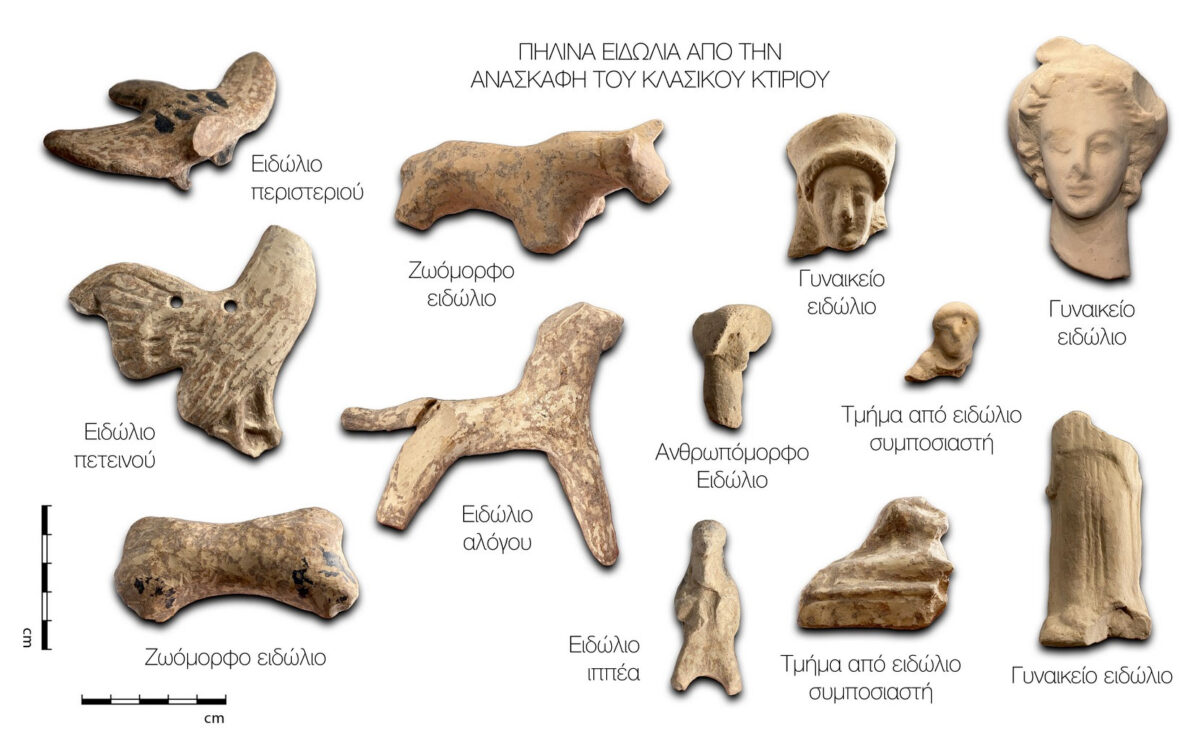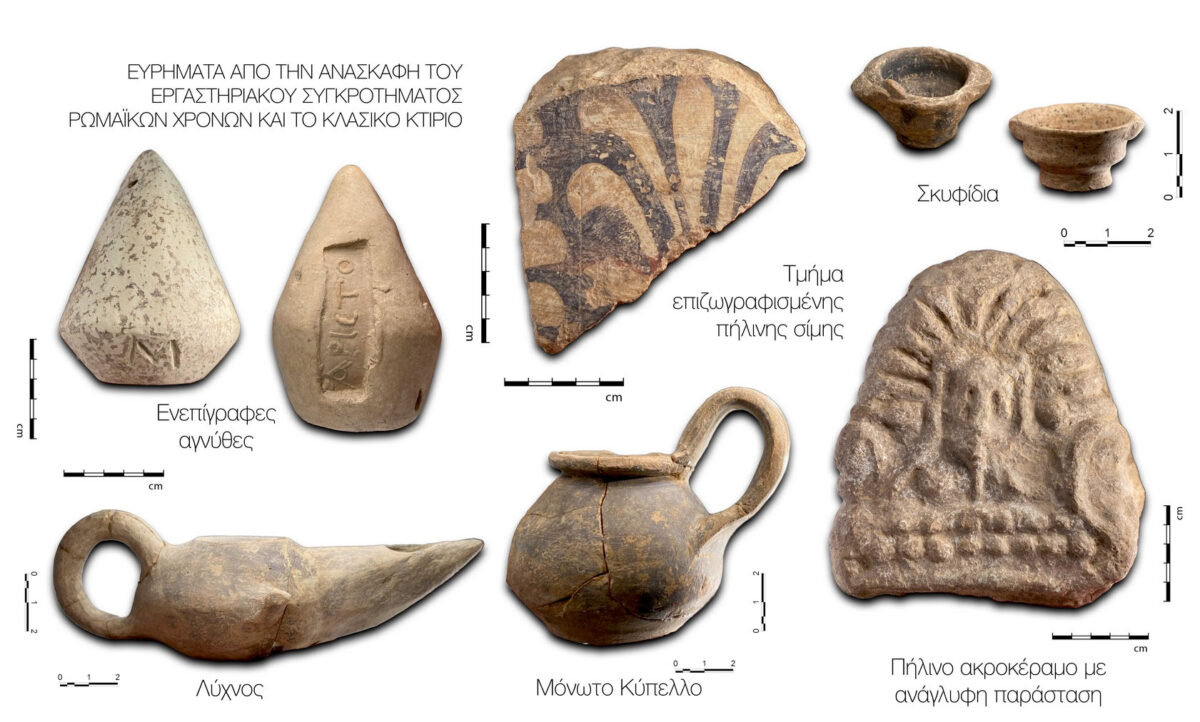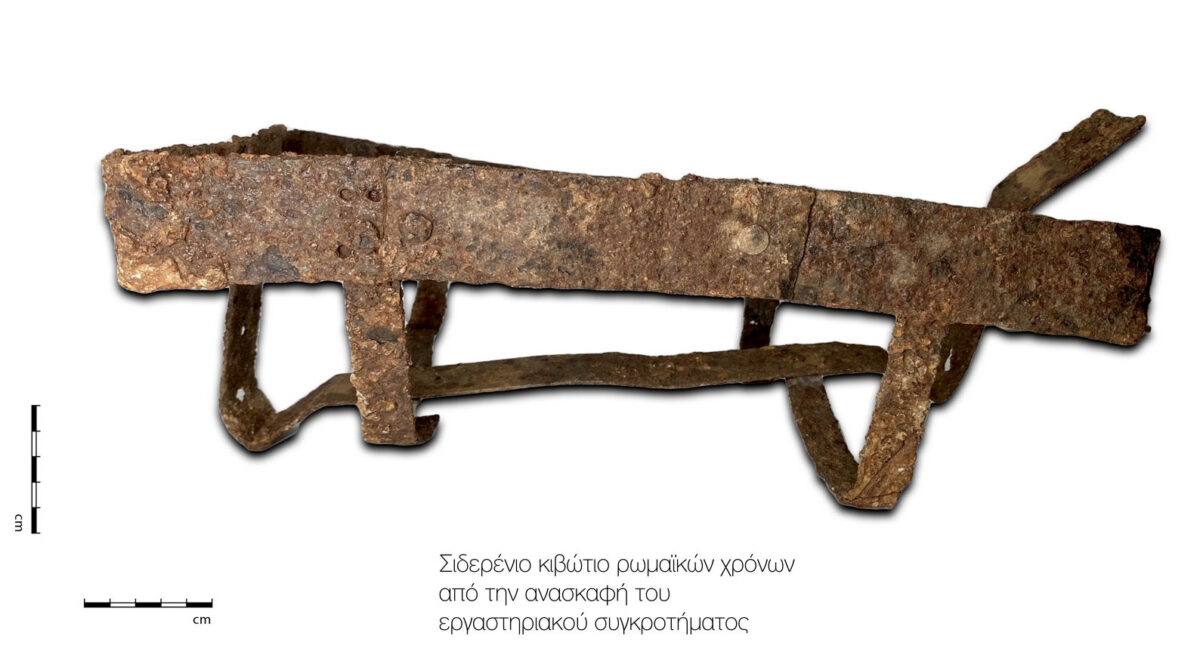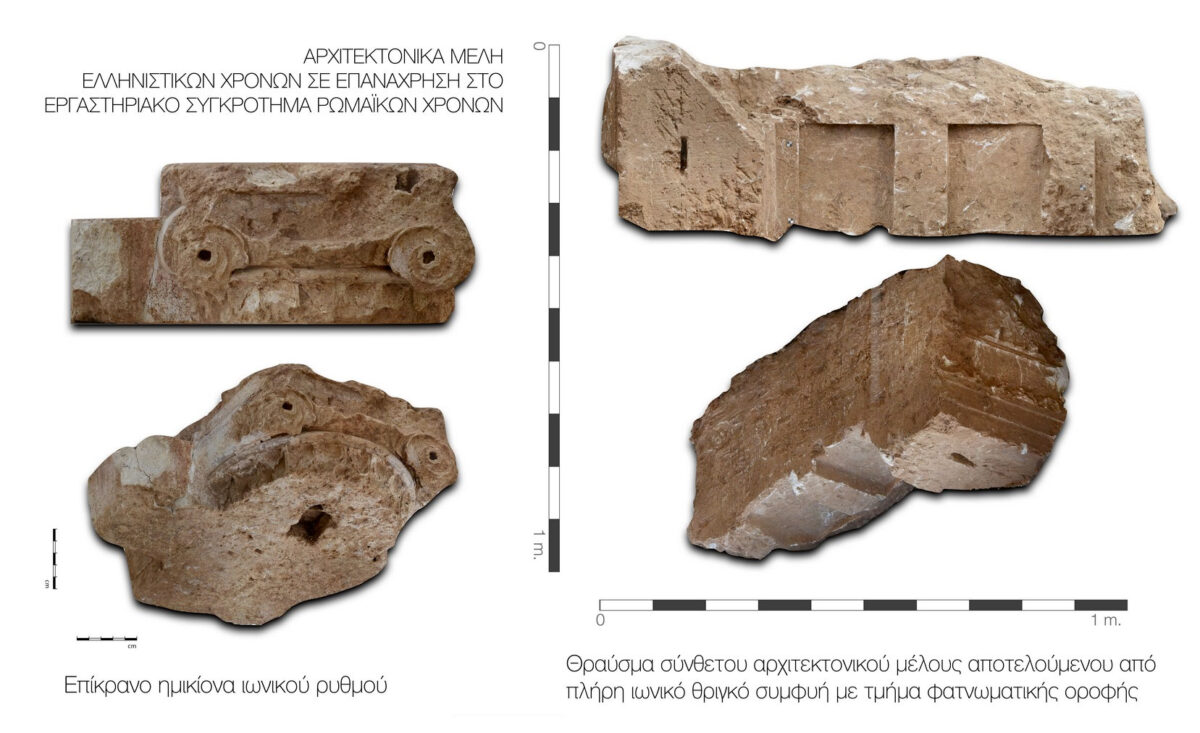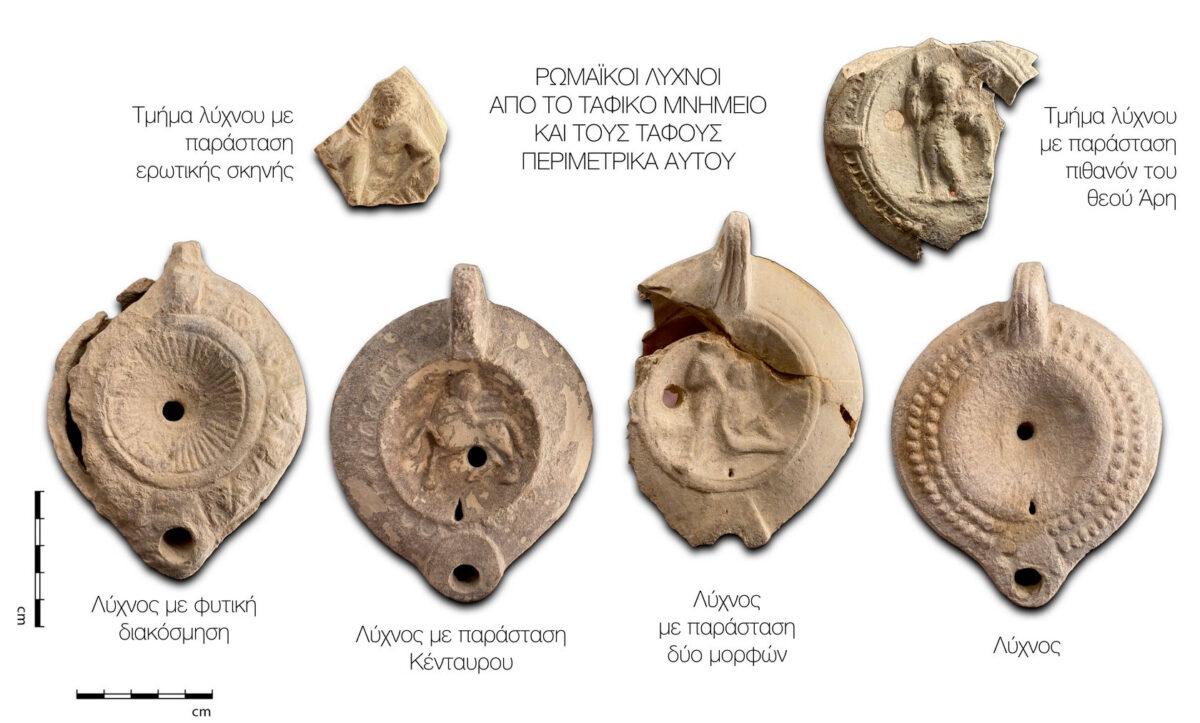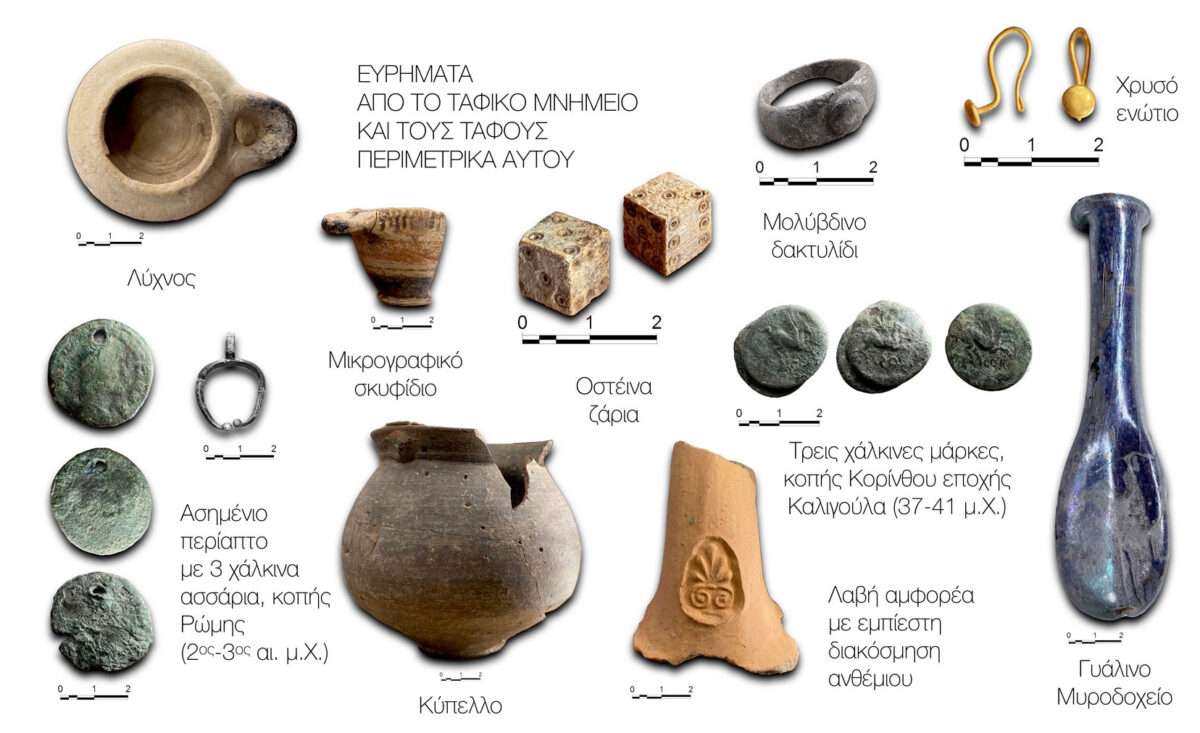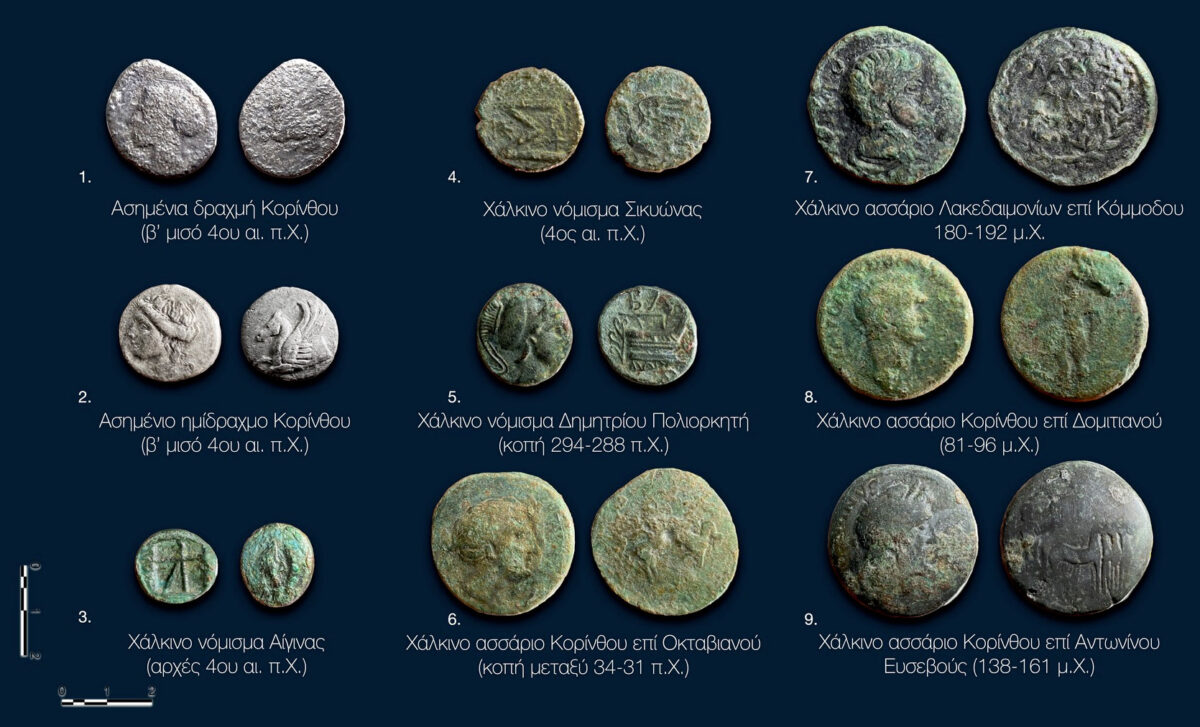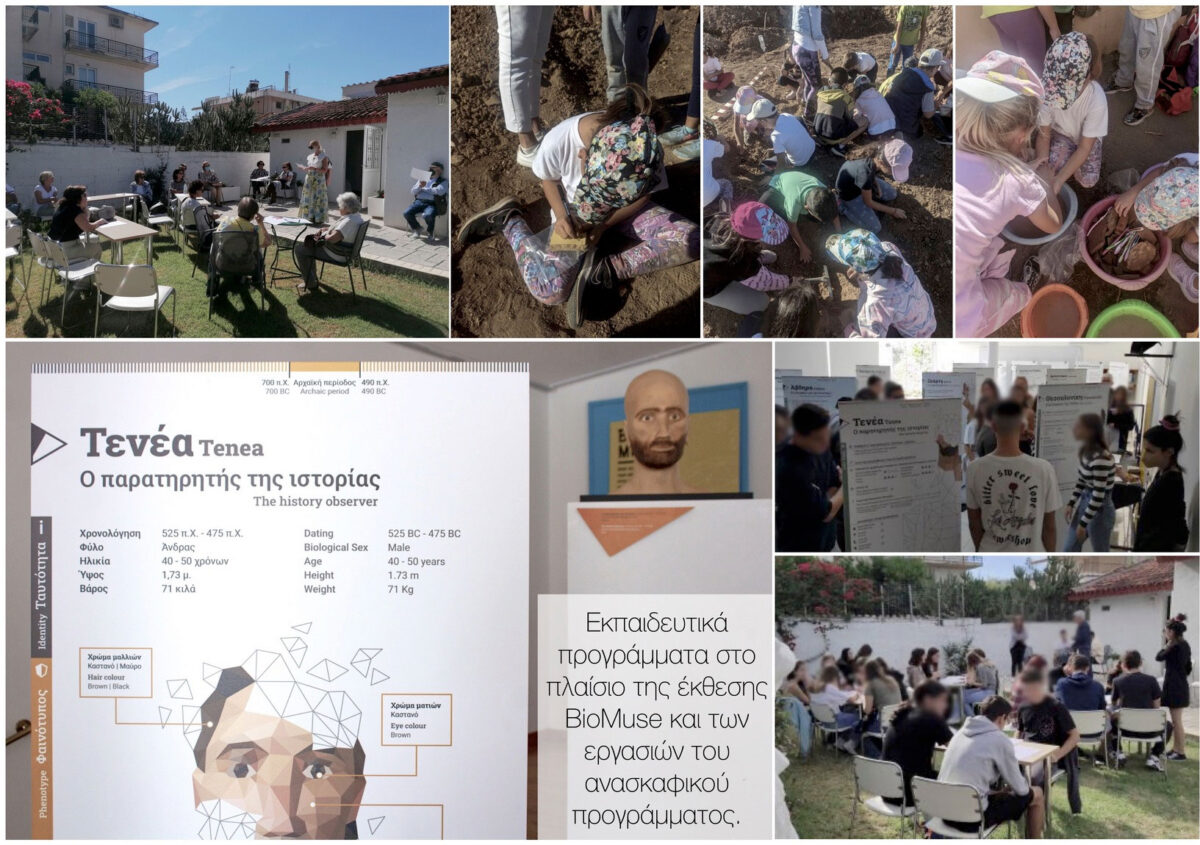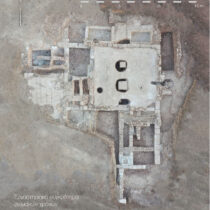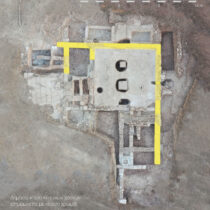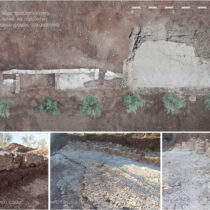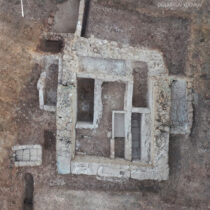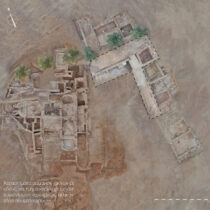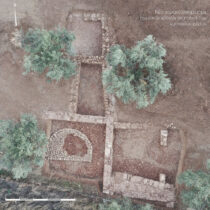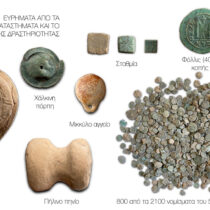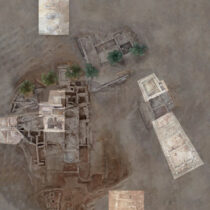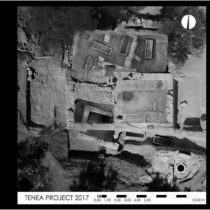In October 2022, the work of the systematic archaeological research project in Chiliomodi, Corinthia, was completed under the direction of Archaeologist Dr. Elena Korka, under the auspices of the Directorate for Prehistoric and Classical Antiquities of the Ministry of Culture and Sports, Athens.
For the first time in 2022, the site of the settlement of the classical city of ancient Tenea was identified. The excavation revealed a public building, excavated on an area of 145 sq.m. (Fig. 2), with important findings, including a large scatter of votive figurines (Fig. 10), probably associated with an adjacent cult site. At the same time, a strong retaining wall of the Early Classical period was excavated at the city’s boundary (Fig. 3).
At the same time, the size and dynamics of the Roman city continue to impress with this year’s excavation results. In the area of the city’s Roman commercial stores, around 2,100 coins and weights were uncovered in a room of the building, identified as the seat of a local official (Fig. 5). In addition, a second above-ground funerary monument (Fig. 4) was unearthed, which, in conjunction with the first one found in 2016, demonstrate the economic vitality and prosperity of Roman Tenea. Finally, an oversized cistern of about 130 sq.m. was excavated, probably the central water storage supply of the Roman city (Fig. 3), showing the extent of its population in this period.
The research program of Ancient Tenea was also active in the sector of educational programs by co-organizing the temporary exhibition BioMuse “From bone fragments to human stories”, where museo-educational activities and creative writing workshops were held, both in the excavation field and in the exhibition space (Fig. 17). The attendance exceeded all expectations, with the participation of more than 1000 students and visitors for only one month.
More specifically, regarding the excavation process, four new area-trenches were investigated, one of which in the space of the city’s commercial activity in the vicinity of the roman baths and the others in areas to the east and northeast of the first.
Regarding the rooms of commercial activity (Fig. 5), the investigation of the city block, delimited to the north by the central cobbled road leading to the baths and to the west by a smaller side road leading to the commercial stores, was completed. More specifically, three new identical stores were revealed on the E/W axis, parallel and adjacent to the south of the main cobbled road, which had an underground area and whose operation is chronologically linked to the early construction phases of the baths.
At the crossroad formed between the main road and the side, a new room with internal dimensions of approximately 3.90m x 4.30m was excavated. This room is the northernmost room of the complex, which was excavated since 2020. During previous excavation periods, a total of 202 coins and the hoard of 30 gold coins of the emperors Marcian, Justin I and Justinian were found in the adjacent room. In the new space investigated this year, 2100 coins of the 5th and 6th centuries A.D. were discoved in the same destruction layer (Fig. 7). Among them a follis of Cyzicus of 543 A.D., nummi of Theodosius, Marcian, Leo I, Zeno, Anastasius, Justin I and Justinian I (Fig. 7), as well as a bronze coin minted in Aegina in the 4th century B.C. (Fig. 16.3), stand out. Apart from the coins, a lead and two bronze weights, as well as a bronze needle were found(Fig. 7). This building was founded on an earlier Roman building, which was excavated at greater depth. The extremely large number of coins located, including valuable hoards and weights, indicate the possible identification of the building with the headquarters of a local ruler or official of the Roman city.
The excavation increasingly adds to the picture of the commercial center of Roman Tenea by revealing the expansion of the commercial activity areas on the SW to NE axis with a recurring pattern. This was also the case in a test trench carried out on the same axis at 120 m to the north, which revealed a new area of similar typology to those to the south.
To the east of the above-mentioned areas a new building was found, four rooms of which were excavated last year, covering an area of 156 sq.m. (Fig. 6). These structures consist of strong walls, some of which bear mortar. A hoard of eighteen silver and bronze coins of the 3rd century AD, minted by Valerian, Galinus and Salonina (Fig. 9), was found in one of the rooms. In addition, thirteen other coins of the 4th and 5th centuries A.D., an iron axe, an iron key, an iron arrowhead, an iron stylus and utilitarian pottery of Roman times were found (Fig. 8).
North of the above trench at about 310 m., a building of classical times was revealed in an area of 145 sq.m. (Fig. 2), which seems to extend both to the west and to the south. Even though parts of the building were removed during the Roman times, important evidence of its foundation are preserved. In the lower levels of the structure, an important amount of pottery from the Archaic and Classical periods was detected, including a significant number of miniature vases, lamps (Fig. 11) and figurines depicting deities, reclining figures, birds, horses, and other animals (Fig. 10). From the same space, coins of the 4th century B.C were collected, such as a Corinthian drachma and hemidrachm (Fig. 16.1, 16.2).
During the Roman period, the site was turned into an organized workshop complex (Fig. 1), bearing an “opus spicatum” floor of excellent quality and three kilns and two rectangular cisterns. The findings collected mainly consist of kiln supports and loom weights (Fig. 11), one of which bear an inscription of the name “ΑΡΙΣΤΟ”. Finally, the use of part of the site as an olive press is also evident according to the preserved remains and the relevant trapetum imprint, in combination with the abundance of olive cores found, some of them inside an iron box (Fig. 12). From the reuse of the site in the Roman period, two pillars and architectural members of excellent stone carving were detected, originating from a building of Hellenistic times (Fig. 13) and more specifically a massive fragment of a complex architectural member consisting of a complete entablature (epistyle, undecorated frieze and dentil eave) inherent with a part of a coffered roof, a capital of an ionic semi-column, a fragment of a Doric column drum, a fragment of Doric semi-column drum with its lower part unfluted, a fragment of an unfluted colonette and sima part.
East of the above, at the boundary of the cemetery zone, an above-ground funerary monument of the Roman times with an underground burial chamber was revealed (Fig. 4). The monument has dimensions of 4,5 m. x 5 m. and is oriented N/S with the entrance to the south. Inside the burial chamber, four cist graves were located. At a later chronological phase, a fifth cist grave was added with the use of an earlier monolithic sarcophagus. In addition, in the SW corner of the chamber, a child’s burial was found in a tile – covered pit grave. In general, the monument and the burials in its inside, were looted and the bones were partially or completely disturbed. Among the findings from the above-mentioned graves, a pendent with three bronze assaria minted in Rome, a hoard of three bronze “tokens”, a coin minted in Corinth in the 1st century B.C., a bronze coin minted in Athens in the classical period, a lamp with a representation of the god Mars, a glass unguentarium, an urn, a cup and a lamp of the 5 th century B.C. stand out (Fig. 14, 15).
The area outside and around the perimeter of the funerary monument was used for burials during Roman times. More specifically, two looted cist graves were located, which were adjacent to the eastern and western wall of the monument, as well as three intact tile-covered pit grave and a looted cist grave. What is extraordinary is the discovery of a tile-covered pit grave, belonging to a child, inside of which two bone dices, two rings of lead and silver, a gold earring, a lamp with a representation of a centaur, a cup, a bronze coin of Gordian and fragments of a bone pin and a bone miniature spoon were collected (Fig. 14, 15).
It is characteristic, in general, that for the construction of the cist graves, material from earlier graves was reused, as well as an archaic Doric capital (second half of the 6th century B.C.) on which part of the abacus is preserved, while the circular trace of the echinus that has been removed is still distinguished. This particular capital was reused as a slab. The large quantity of archaic pottery that was collected from the site is impressive. In the northwest of the funerary monument, at the depth of its foundation, an earlier rectangular cistern was unearthed.
This funerary monument together with the above-ground two-room funerary monument discovered in 2016 clearly indicate the eastern boundary of the Roman city.
East of the new funerary monument a strong retaining wall of rectangular isometric, porous, carved stones was excavated at a length of 18m (Fig. 3). The wall has an E/W direction and the pottery from its foundation dates to the early classical period. At one point, the wall seems to have been interrupted in Roman times for an oversized cistern to be build.
The cistern has internal dimensions of 15,2 m. x 8,40 m., E/W orientation and covers an area of about 130 sq.m. Strong masonry is preserved in the south and in part of the east and west by walls of 0,90 m. width with a maximum height of 0,80m., Dr Elena Korka Honorary Director General of Antiquities and Cultural Heritage of the Ministry of Culture and Sports Director of the Excavation of Ancient Tenea internally plastered, while strong external buttresses are formed. Its floor is extremely well constructed and covered by mortar. It was constructed with vertical tiles on a thick layer of mortar and stones. In the southeast corner of the cistern, a built ladder of descent is preserved. This cistern probably served to supply water to the Roman city.
The research program of ancient Tenea during 2022 excavation period was involved, in addition to the archaeological research, in the BioMuse exhibition “From bone fragments to human stories” co-organizing it with the Laboratory of Physical Anthropology of the Democritus University of Thrace, Tetragon S.A., the Municipality of Corinth and the Kalogeropouleio Foundation, which was hosted at the Kalogeropouleio Foundation in Corinth from September 17 to October 17. This exhibition was the result of the BioMuse research project, a partnership of institutions from Greece and Germany. It shows with modern physical and digital media the biographies of ten humans who lived in Greece during the last 11,000 years: Among them a citizen of Tenea of Archaic times (Fig. 17). The exhibition was inaugurated in Corinth by the Secretary General of the Ministry of Culture and Tourism, Mr. G. Didaskalou, in the presence of the Deputy Minister of Environment and Energy Mr. N. Tagaras, local congressmen, the Deputy Governor of Corinthia Ms. A. Korka, the Mayor of Corinth, Mr. V. Nanopoulos, local authorities and a large number of people.
In addition, the research program of ancient Tenea was also active in museum educational activities and creative writing workshops, which were held both in the exhibition area and in the archaeological field for pupils (private and public primary, secondary and high schools of the region of Corinthia), students and adult visitors of the exhibition (such as the associations: Friends of the Numismatic Museum, Friends of the Benaki Museum, and others.). Furthermore, guided tours and educational programs even for early childhood students were conducted by the scientific collaborators of the archaeological program of ancient Tenea in cooperation with the respective teachers.
The program under the direction of Dr. E. Korka is supported by an interdisciplinary team of archaeologists under the responsibility of Mrs. P. Evaggeloglou, archaeologist of the Ephorate of Antiquities of Corinth, numismatists under the responsibility of Dr. C. Lagos, anthropologists under the responsibility of Associate Professor C. Papageorgopoulou (D.U.TH.), topographers under the responsibility of Professor A. Georgopoulos (N.T.U.A). In the context of the above collaborations, modern methods of photogrammetric imaging, three-dimensional display of the different sites, objects, and anthropological material were applied. Again, this year, students from Greek Universities participated under the supervision of archaeologists P. Vlachou, M. Ioannou, P. Panailidis, I. Christidis, P. Kostopoulou., E Kapouralou., architect Dr. D. Bartzis, topographers A. Anastasiou, A. Kontoudaki and conservator T. Papageorgiou. Dr. M. Hapsa, teacher, philologist at the 4th High School of Corinth and author, created for the BioMuse exhibition and curated during its duration the above-mentioned museum-educational programs and carried out the (also mentioned above) creative writing workshops, while the guided tours and educational activities were implemented by the archaeologists and postgraduate students of museology A. Kyriazi, P. Labiri, E. Lyggri and A. Kratsi.
For their generous support we warmly thank: The Region of the Peloponnese, the Municipality of Corinth, Companies, MYTILINEOS S.A., FYRKO S.A thanks to whom our research is carried out, as well as the Corinthian Aristotle School and the early childhood center “Happyland” for their contribution to our educational activities. We also thank the Association “Friends of Ancient Tenea” and the residents of Chiliomodi for supporting our work. In addition, we thank Mr. PanagiotisTakis, Maria Pazarli., Andreas Skourtis, Panagiotis Skourtis, Nikos Skourtis, Klery Mezini, Kleoni Mezini, Sofia Mezini, Panagiotis Delis who agreed to the investigation of their fields. A special thank you to Manousos and Maria Manousaki, Thomas Athanasakos and Panayiota Vourvopoulou for hosting our main researchers and collaborators. Finally, we would like to thank the General Directorate of Antiquities and Cultural Heritage, Directorate of Prehistoric and Classical Antiquities and the Ephorate of Antiquities of Corinth as well as the Directorate for the Conservation of Ancient and Modern Monuments, the Ephorate of Antiquities of Athens and the Numismatic Museum for their support.
